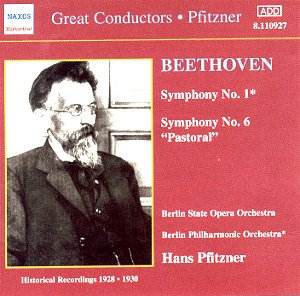To mark the centenary of Beethoven’s death English
Columbia released a raft of prestigious recordings, amongst them the
complete symphonies with a number conducted by the august Felix Weingartner.
In Germany Grammophon released its own competing series – parcelled
out to Pfitzner, Richard Strauss, Oscar Fried and Erich Kleiber – but
unlike Columbia’s, Grammophon’s series (often to be found on its Polydor
export series) wasn’t to be completed until a tardy 1933. Pfitzner undertook
the recording of the lion’s share, with five symphonies to his credit.
It’s often overlooked that he had a distinct career as a conductor –
in Strasbourg amongst other places – and in certain respects at least
seems to have been considered as accomplished a Beethoven conductor
as the more internationally successful and known Weingartner. Pfitzner’s
virtues were very much those of the subjective German school: tempo
fluctuations, moulded string sonorities, affectionate wind choirs, a
flexible tempo rubato, considerable weight of "bass up" string
tone and in relation specifically to his recording career a pervasive
use of the rallentando to mark side breaks. This was a constant feature
of many artists’ recordings in the 78 era and has always seemed to me
at least as significant a distortion of performance practice as the
much more commonly explored area of tempo – and the rushing adopted
(or not) to accommodate a piece of music onto a 78 side. One can hear
the rallentando on several occasions here – and it was a musical solution
to an unmusical problem, if for us now perhaps something of a difficulty
to reconcile within the context of a given tempo or variance from it.
These 1928-30 Polydor recordings (Polydor was the German
Grammophon Company’s export label) are difficult precisely to date but
have been well transferred by David Lennick, albeit the originals are
definitely inferior to the slightly earlier Columbia series made in
London. Equally they show Pfitzner in both spirited and spiritual engagement
– and also on occasion as a slightly less successful practitioner. The
First Symphony receives much the less compelling reading and not merely
because of the relative standing of the two works. There’s a curious
sense of detachment throughout much of the symphony – not indifference
exactly, but rather more as if Pfitzner had less need or desire to devote
weight of impress upon it. Rob Cowan, sleeve-note writer, calls it "stylistically
unexceptional" and it’s true that whilst there is, from time to
time, a certain affectionate profile the work as a whole is rather disappointingly
underplayed.
Contrast the Pastoral, which clearly engaged
Pfitzner to a very considerable degree. There is some cavernous lower
string moulding in the first movement, with quite splendid cellos and
a sense of continuum and flux. The elasticity is generated at quite
a slow tempo and those rallentandos are particularly noticeable here;
note as well the very heavily and italicised shaping of the wind choir’s
responses to the strings. The second movement is again romantically
and indeed pictorially beautiful, with Pfitzner never holding back from
encouragement of his wind principals whilst allowing them sufficiently
flexible tempi to allow them to phrase with sometimes idiosyncratic
freedom. The scherzo is quite slow but the fourth movement is powerful
and taut whilst the finale, though once more slow, has a flexible, subjective
and incremental power that I find enormously persuasive.
The Pastoral was one of the best, if not the
best, of Pfitzner’s Beethoven cycle; full of insight, affection and
detail it repays study, both in terms of what he saw in the symphony
and in terms of conducting practice generally.
Jonathan Woolf

![]() Berlin Staatsoper
Orchestra [No 6]
Berlin Staatsoper
Orchestra [No 6] ![]() NAXOS 8.110927 [63.50]
NAXOS 8.110927 [63.50]